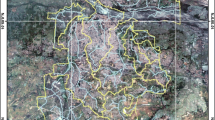Abstract
The broad objective of the present study is to estimate the daily runoff from the rainfall data using SCS-CN (Soil Conservation Service-Curve Number) method for Kothapally agricultural field. The data of daily, monthly, and yearly rainfall, temperature, relative humidity, wind speed, evaporation data of 11 years data from 2006–2016, was collected from the ARI (Agricultural Research Institute, Rajendra Nagar), Hyderabad. The data collected such as rain fall and also analyzing temperature, and humidity and wind velocity, relative humidity which is collected from the ARI (Agricultural Research Institute), Rajendra Nagar data collected from the International Crops Research Institute for the Semi-Arid Tropics (ICRISAT), and NIRD (National Institute of Rural Development) Hyderabad, and Fifth economic census 2005 issued by the Directorate of Economics & Statistics, Hyderabad. The present study area Kothapally agricultural field involves collection of service data like satellite data, survey of India topo sheets, and prepares various thematic maps like base map, contour map, drainage map, soil map, slope map, land use/land cover map are prepared by using survey of India topo sheets and satellite imageries. The methodology is used for the analysis of data is the Soil Conservation Service-Curve Number (SCS-CN) for computation of runoff, and regression analysis by using rainfall and estimated runoff of daily, monthly, yearly from collecting data and also calculate the correlation coefficient and coefficient of determination.
Access this chapter
Tax calculation will be finalised at checkout
Purchases are for personal use only
Similar content being viewed by others
References
Malleswara Rao, B.N.: GIS based action plan for water resources management, a case study of a central India kothapally agriculture field. In: Proceedings of 3rd international conference on hydrology and kothapally agriculture field management, vol. II, pp. 956–964 (2010)
“Use of Satellite Data for Kothapally Agriculture Field Management and Impact assessment”, J. Int. Crops Res. Ins. Semi-Arid Tropics (ICRISAT), Patancheru, Andhra Pradesh, India, 149–157, (2008)
Capece, J.C.: Estimating runoff peak rates and volumes from flat, high-water-table kothapally agriculture fields. Master’s Degree thesis, University of Florida, Gainesville, Florida (1984)
Bultot, F., Dupries, G.L., Gellens, D.: Simulation of land use changes and impact on the water balance-a case study for Gelgium. J. Hydrol. 114, 327–348 (1990)
U.S. Soil Conservation Service Technical Release 55: Urban Hydrology For Small Kothapally Agriculture Fields. USDA (U.S. Department of Agricultural), June 1986, (1986)
Heatwole, C.D.: Field and basin scale water quality models for evaluating agricultural nonpoint pollution abatement programs in a South Florida flatwoods kothapally agriculture field. Ph.D. dissertation, University of Florida, Gainesville, Florida (1986)
Garg, N.K., Sen, D.J.: Determination of kothapally agriculture field features for surface runoff models. ASCE, J. Hydrol. Eng. 18(4), 427–447 (1994)
Sridhar, P.S.N., Jowhar, T., Garg, A., Kedareswarudu, U.: “A Framework of Information Technology for Water Resources Management”, Int. J. Comp. Appl, Vol. 30, No. 5, September 2011, (2011)
Pahari, K., Delsol, T., Murai, S.: Remote sensing and GIS for sustainable kothapally agriculture field management a study from Nepal. Paper presented at the 4th symposium on high mountain remote sensing cartography, Karlstad- krishna- Thoma, 19–29 Aug 1996
Kachroo, R.K.: Homs work shop on river flow forecasting Nanjing China. Unpublished international report, Department of Engineering Hydro, University college Galway Ireland (1986)
Joshi., Pangare., Shiferaw, B., Wani, S., Bouma, J., Scott.: “Watershed development in India: Synthesis of past experiences and needs for future research”, Indian J. Agri. Eco, July 2004, (2000)
Author information
Authors and Affiliations
Corresponding author
Editor information
Editors and Affiliations
Rights and permissions
Copyright information
© 2019 Springer International Publishing AG, part of Springer Nature
About this paper
Cite this paper
Ramana, G.V., Suresh Kumar, R., Balakrishna, P. (2019). Restoration of Ecological Balance Through Regression Analysis in Kothapally Agricultural Fields. In: Rao, P., Rao, K., Kubo, S. (eds) Proceedings of International Conference on Remote Sensing for Disaster Management. Springer Series in Geomechanics and Geoengineering. Springer, Cham. https://doi.org/10.1007/978-3-319-77276-9_74
Download citation
DOI: https://doi.org/10.1007/978-3-319-77276-9_74
Published:
Publisher Name: Springer, Cham
Print ISBN: 978-3-319-77275-2
Online ISBN: 978-3-319-77276-9
eBook Packages: EngineeringEngineering (R0)




